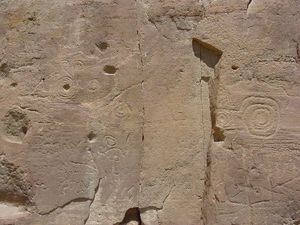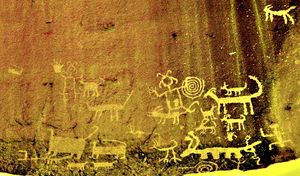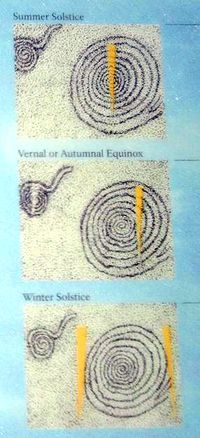Chaco Canyon Petroglyphs
The Chaco Canyon Petroglyphs are a series of symbols carved into the stone walls of Chaco Canyon located in the Chaco Culture National Historical Park, New Mexico. The petroglyphs are depictions of many different symbolic items including animals, celestial markers, and humanoid figures, as well as more abstract imagery such as swirls and lines. [1]
History
These works were created by the ancestral Pueblo peoples circa. 850 – 1250 AD. [2]

Archaeologists believe many of the symbols were functional and that they were used to mark and keep track of the changing of the seasons. [4] Some archaeologists believe that these petroglyphs were also documentation of celestial events. Research has shown that during the occupation of Chaco Canyon between 800 – 1250 AD, a solar eclipse likely took place. Archaeologists argue petroglyphs depicting images such as circles surrounding by branching arms, much like a sun, could have been documentation of this solar eclipse. [5] According to the Chaco Culture National Historic Park, the images depicted in the limestone of Chaco Canyon were most likely crucial forms of communication which includes acting as records of kinship and migratory systems. Further, it appears they were used to document songs, stories, and ceremonies. Even today, descendants of the Chacoan people see refer to the petroglyphs for migratory histories of the various clans from the area. [6]
Discovery
Chaco Canyon had been inhabited on and off by nomadic peoples starting as early as 12,000 BC but was settled finally in 800 AD. The Chacoan people built many structures within the canyon that are considered to be monumental feats of architecture sometimes equated with those of ancient Egypt. By 1250 AD however, many of the people occupying the canyon had moved on and the location was abandoned. It was rediscovered in 1823 by New Mexican governor José Antonio Vizcarra who documented the site during an expedition through the state. It was made an United Nations Educational, Scientific and Cultural Organization (UNESCO) World Heritage Site in 1987. [7]

Pseudoarchaeological Narrative
According to fringe theorists and pseudoscientific interpretation, many of the petroglyphs depict extraterrestrial life or images of space travel. One example is a depiction of a humanoid figure with two protruding “antennae” extending from their head that appears to be holding a spiral “galaxy” in his hand. Pseudoarchaeologists such as Giorgio Tsoukalos in the television series “Ancient Aliens” suggest that these images are representations of space travel and extraterrestrial knowledge.[9] Many of these petroglyphs were carved in places that are not easily accessible which implies there was effort put into placing them in specific locations. Tsoukalos asks, “Why would anyone climb up here (the canyon) and depict scenery like this (the symbol of the man and the spiral) unless it merited all this effort?” he continues by saying, “They (the ancestral Pueblo peoples) knew what they were carving, they knew that what they did was very significant, and we have to look at it as such.” [10] Many claims in of this nature look at the surface imagery without considering the context.

Deconstruction
Petroglyphs are symbols carved into stone with another rock by scraping or pecking. While many are aesthetically pleasing, these symbols are not just art. Petroglyphs convey meaning, sometimes complex and sometimes straightforward. According to Exploratorium, “Interpreting rock art (petroglyphs) can be difficult…an archeologist must know something about that culture (that created the petroglyphs) in order to consider what the rock artist was trying to say.”[12] Archaeologists are studying the culture of the people who occupied Chaco Canyon and this provides them with context for interpretation of these symbols and their meaning. For example, the swirl image Tsoukalos implies is a depiction of a galaxy is called the Sun Dagger petroglyph. Researchers have discovered that the petroglyph was used by the Chacoan peoples to monitor and keep track of the seasonal solstices. [13] While there are depictions of other images that could be interpreted as celestial, archaeologists hypothesize these depictions symbolize events that happened on Earth and not in space, such as the symbols potentially describing a solar eclipse. These scientists did not come to this conclusion only because the petroglyphs looked like a sun, but by observing the context of the time period and the people’s tendency to look skyward for religious and cultural ceremony.[14]
References
- ↑ NPS (2016), Petroglyph Trail, Chaco Culture National Historical Park, National Park Service, Retrieved from: https://www.nps.gov/chcu/planyourvisit/petroglyph-trail.htm
- ↑ NPS (2016), The Center of an Ancient World, Chaco Culture National Historical Park, National Park Service, Retrieved from: https://www.nps.gov/chcu/index.htm
- ↑ Bodnar, R (2016) Petroglyph Trail, Chaco Culture National Historical Park, National Park Service, Images retrieved from: https://www.nps.gov/chcu/planyourvisit/petroglyph-trail.htm
- ↑ MSU (2015), Chaco Canyon Petroglyphs, Michigan State University, Retrieved from: http://pseudoarchaeology.leadr.msu.edu/chacocanyonpetroglyphs/
- ↑ Scott, J (2017), Chaco Canyon petroglyph may represent ancient total eclipse, Colorado University Boulder, Retrieved From: https://www.colorado.edu/today/2017/08/08/chaco-canyon-petroglyph-may-represent-ancient-total-eclipse
- ↑ Bustard, W (2005), The Museum Collections of Chaco Culture National Historic Park, National Parks Service Museum Management Program, Retrieved from: https://www.nps.gov/museum/exhibits/chcu/index6.html
- ↑ Hubka, S (2019), Chaco Canyon: The Ancient Ruins of New Mexico, Roads Unraveled, Retrieved from: https://www.roadunraveled.com/blog/chaco-canyon-new-mexico/
- ↑ MSU (2015), Chaco Canyon Petroglyphs, Michigan State University, Retrieved from: http://pseudoarchaeology.leadr.msu.edu/chacocanyonpetroglyphs/
- ↑ Tsoukalos, G (2019), Chaco Canyon Petroglyphs, Ancient Aliens, History Channel, Retrieved from: https://www.history.com/shows/ancient-aliens/videos/chaco-canyon-petroglyphs
- ↑ Tsoukalos, G (2019), Chaco Canyon Petroglyphs, Ancient Aliens, History Channel, Retrieved from: https://www.history.com/shows/ancient-aliens/videos/chaco-canyon-petroglyphs
- ↑ MSU (2015), Chaco Canyon Petroglyphs, Michigan State University, Retrieved from: http://pseudoarchaeology.leadr.msu.edu/chacocanyonpetroglyphs/
- ↑ Marks, R (1985-2019) Make Your Own Petroglyphs, Exploratorium, Retrieved from: https://www.exploratorium.edu/chaco/HTML/TG-petroglyphs.html
- ↑ MSU (2015), Chaco Canyon Petroglyphs, Michigan State University, Retrieved from: http://pseudoarchaeology.leadr.msu.edu/chacocanyonpetroglyphs/
- ↑ Scott, J (2017), Chaco Canyon petroglyph may represent ancient total eclipse, Colorado University Boulder, Retrieved From: https://www.colorado.edu/today/2017/08/08/chaco-canyon-petroglyph-may-represent-ancient-total-eclipse